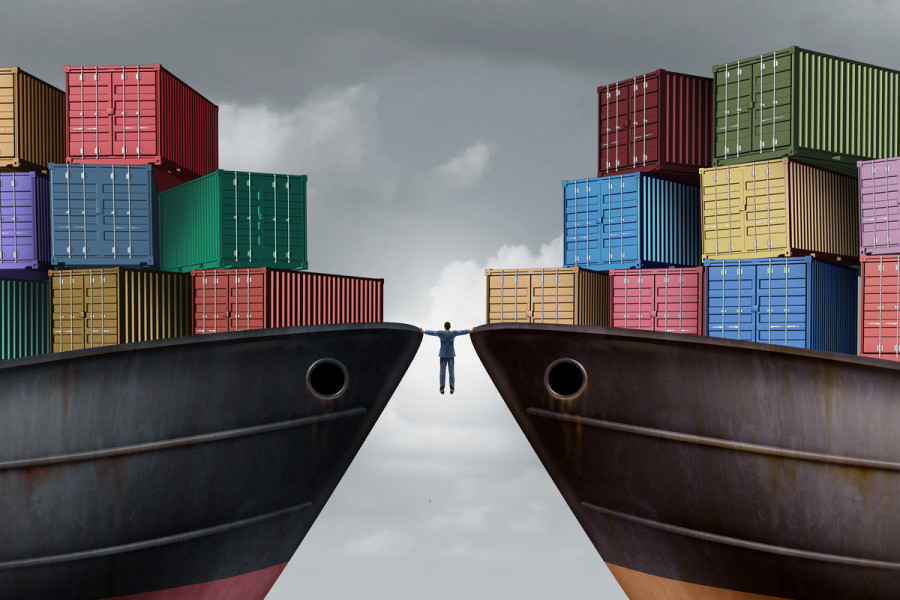Columns
Faulty assurances
Nepal turned into a net food importer from an exporter after the 1980s due to abysmal farm policies.
Bijendra Man Shakya
Nepal released the budget estimate for fiscal 2022-23 last month when the country was passing through a desperate economic situation. Mired in the after-effects of the pandemic and the war in Ukraine, Nepal saw its trade deficit balloon due to an unprecedented rise in imports which outstripped sluggish export growth. That depleted the country’s foreign exchange reserves happened during the pre-economic reform in the early 1990s. According to Nepal Rastra Bank, foreign currency holdings shrank by 21.1 percent to $9.28 billion in mid-May 2022 from $11.75 billion in mid-July 2021. This is barely enough to pay for six months' imports while the minimum reserve requirement to be comfortable is for 11 months' imports.
While this indicated a fragile external economic condition, there was apprehension that the Nepali economy was following the Sri Lankan path. Grappling with acute foreign exchange shortages, the Sri Lankan economy is in the grip of a massive supply shortfall, runaway fuel price increase and foreign debt defaults. Although Nepal's situation is not as precarious as that of Sri Lanka, it may face such risks if steps are not taken to keep the economy in order.
Trade balance
In that context, it is interesting that the current budget estimate has placed the country’s external trade sector at its centre. With the goal of maintaining the trade balance in the next five years, it has aimed to reduce overall imports by 20 percent and imports of food crops by 30 percent, and double the export volume by the next fiscal year. To meet these objectives, the budget has included fiscal measures applicable to import bans and import substitution, and incentives for export promotion. This shows some rationality, but there are reasons to suspect the means to meet these ends.
To begin with, let’s examine the policy of controlling imports. For an import-oriented economy like Nepal, it is easier said than done. While there is a possibility of bias in selecting the products that will see controls, this will have an instant effect on the consumer price index due to the difficulties the economy finds in adjusting production internally. However, if the economy is well endowed with resources and enjoys a friendly business environment, it can encourage domestic producers to substitute imports when prices increase. But this is not likely to happen, given the current economic situation in the country. Equally important is the impact of import restrictions on revenue generation to the economy, which depends excessively on import tariffs. A debate on this issue has already emerged.
Nevertheless, the measures introduced by the budget to substitute farm and energy imports look reasonable and relatively more practical. Yet their outcome will depend on the extent and efficacy of government support in the respective fields.
The proposed budget has given continuity to fiscal measures in agriculture, like the farmers’ welfare fund, subsidies for sugarcane farmers and subsidised agriculture insurance premiums. But these measures have allegedly been accused of diverting benefits from the needy to intermediaries. If that’s the case, a productivity-based subsidy would have been a better choice, not only to overcome these drawbacks, but also to boost farm output. There is no other easier choice than to increase output to meet the challenges of substituting agriculture imports and food security which has dominated the economic debate for some time. Nepal has turned into a net food importer from a net food exporter after the 1980s due to the politics of modernisation and economic growth; regional geopolitics and increasing market dependence; ineffective government agricultural policies and food imports; and political instability and the Maoist insurgency.
Now let’s turn to the fiscal measures that are aimed at substituting energy imports. The government has introduced through the budget proposal a specific policy to encourage the use of electricity in households as a substitute for imported cooking gas, which accounts for about one-fourth of the country’s average annual import value. But it is surprising that the policy has taken the wrong path to achieve its objective. Instead of subsidising electricity so that people will use it more, it has announced a nationwide distribution of electric stoves. There is a marked difference between the two approaches, although both involve costs to the government. While the free distribution of electric stoves adds an instant burden to the government’s budget, the cost of subsidising the electricity bill can be adjusted with the exchequer.
Costly electricity
Therefore, is it reasonable to choose a measure that heaps financial liabilities on the government instead of a policy that manages its financial obligation? It also raises the question of how one can guarantee that Nepali households will switch to electricity when the tariff remains the same. Hence, these complexities will only create impediments to utilising the country’s abundant hydropower as a means of import substitution and improve the deteriorating external sector doubt.
Finally, and perhaps this may be the most important point, the budget has given continuity to direct export subsidies. Besides raising the subsidy to 8 percent, the government has extended it to more products despite an ongoing debate on whether or not the direct cash subsidies have worked in Nepal. A World Bank study found that the direct subsidy had not significantly increased firms’ exports in general. This means that the measures which were announced arbitrarily have nothing to do with the basic objective of promoting exports, which requires innovation-based subsidies given the existing circumstances. So, in conclusion, it is appreciable that the fiscal policy has categorically considered the trade sector to address the country's recent economic woes, but it has failed to pursue a holistic approach to prevent a possible fiasco.




 13.98°C Kathmandu
13.98°C Kathmandu















